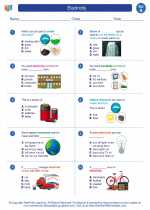Mechanical Energy
Mechanical energy is the sum of potential energy and kinetic energy in an object. Potential energy is the energy stored in an object due to its position or state, while kinetic energy is the energy an object possesses due to its motion.
Potential Energy
Potential energy is the energy stored in an object based on its position or state. The two main types of potential energy are gravitational potential energy and elastic potential energy.
- Gravitational Potential Energy: This type of potential energy is associated with an object's position in a gravitational field. The formula for gravitational potential energy is: PE = mgh, where m is the mass of the object, g is the acceleration due to gravity, and h is the height of the object above a reference point.
- Elastic Potential Energy: This type of potential energy is associated with objects that can be stretched or compressed, such as springs. The formula for elastic potential energy is: PE = 0.5kx^2, where k is the spring constant and x is the displacement from the equilibrium position.
Kinetic Energy
Kinetic energy is the energy an object possesses due to its motion. The formula for kinetic energy is: KE = 0.5mv^2, where m is the mass of the object and v is its velocity.
Conservation of Mechanical Energy
According to the law of conservation of energy, mechanical energy is conserved in the absence of non-conservative forces such as friction or air resistance. This means that the total mechanical energy of an object remains constant as long as only conservative forces are acting on it.
Study Guide
- Understand the concept of potential energy and its different forms.
- Be able to calculate gravitational potential energy using the formula PE = mgh.
- Learn about elastic potential energy and how to calculate it using the formula PE = 0.5kx^2.
- Understand the concept of kinetic energy and be able to calculate it using the formula KE = 0.5mv^2.
- Know the conditions for the conservation of mechanical energy.
By understanding and mastering the concepts of potential and kinetic energy, as well as the conservation of mechanical energy, you will have a solid foundation in the topic of mechanical energy.
[Mechanical Energy] Related Worksheets and Study Guides:
.◂Science Worksheets and Study Guides First Grade. Electricity

 Worksheet/Answer key
Worksheet/Answer key
 Worksheet/Answer key
Worksheet/Answer key
 Worksheet/Answer key
Worksheet/Answer key
